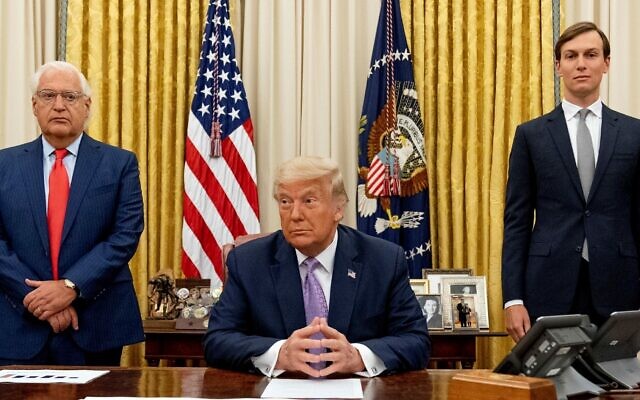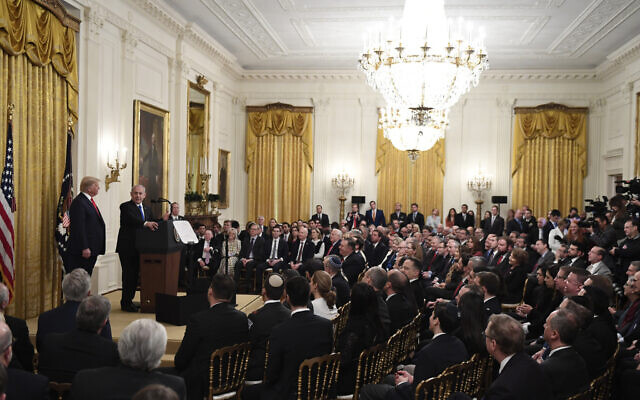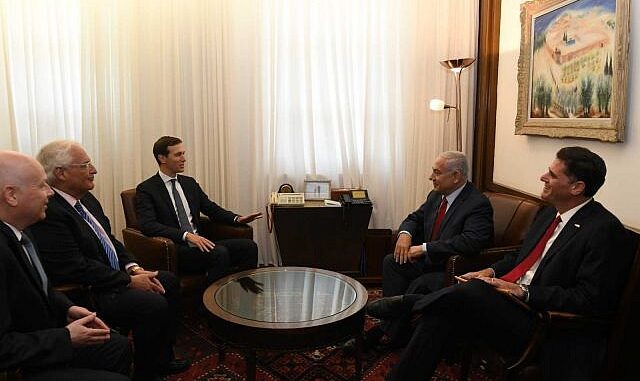T. Belman. I have been curios about this back story. To what extent does Kushner tell it this way in order to keep on god terms with the Arabs?
Top Trump aide says ‘my knuckles turned white’ as Netanyahu used peace plan rollout to promise sovereignty in settlements and Jordan Valley, did so thanks to Friedman’s assurances
By JACOB MAGID, TOI 31 July 2022, 11:17 pm

Then-US president Donald Trump, center, is flanked by then-ambassador to Israel David Friedman, left, and then-senior adviser Jared Kushner in the Oval Office on August 12, 2020. (AP/Andrew Harnik)
US ambassador to Israel David Friedman went rogue when he told then-prime minister Benjamin Netanyahu that the Trump administration would back plans to annex large parts of the West Bank, ex-White House senior adviser Jared Kushner maintains in a new book slated to be published later this month.
Kushner’s account, the latest tell-all from a former Trump administration official to offer a peek into the White House’s somewhat chaotic rollout of its 2020 peace plan, appears to contradict Friedman, who insisted when he published his own memoir earlier this year that he was in lock-step with Kushner on the issue of annexation, which he personally supported.
“The accusation that I was running my own agenda with Netanyahu about [applying Israeli] sovereignty [to parts of the West Bank] and not letting the president know, not letting anybody know, contrary to the wishes of Jared — it’s 100% false, 100% false,” Friedman told The Times of Israel in February.
But Kushner tells a different story in “Breaking History: A White House Memoir,” set to be published on August 23.
In it, Kushner recalls being enraged as Netanyahu used his speech at the January 2020 White House unveiling of the Trump peace plan to announce that the president had become the first world leader to recognize Israel’s sovereignty over much of the West Bank and that as a result Israel would be moving to annex all the West Bank settlements and the Jordan Valley.
For at least the next four years, Israel will maintain the status quo “in areas that your plan does not designate as being part of Israel in the future,” Netanyahu told the US president. “Israel will preserve the possibility for peace.” Then the prime minister added: “At the same time Israel will apply its laws to the Jordan Valley, to all the Jewish communities in Judea and Samaria and to other areas that your plan designates as part of Israel and which the United States has agreed to recognize as part of Israel.”
“This was not what we had negotiated,” writes Kushner.
“Under our plan, we would eventually recognize Israel’s sovereignty over agreed upon areas if Israel took steps to advance Palestinian statehood within the territory we outlined,” he elaborates, insisting that US approval of Israeli annexation would take time and was not a foregone conclusion.

Then-prime minister Benjamin Netanyahu speaks with then-US president Donald Trump during an event with in the East Room of the White House in Washington on January 28, 2020. (AP/Susan Walsh)
“I grabbed my chair so intensely that my knuckles turned white, as if my grip could make Bibi stop. I had explicitly asked Israeli ambassador [to the US] Ron Dermer to make sure Bibi kept his remarks brief and above the politics of the day,” Kushner continues. “In both tone and substance, the speech was way off the mark. It contained nothing magnanimous or conciliatory toward the Palestinians. It was essentially a campaign speech for his domestic political audience, and it misrepresented our plan.”
As Netanyahu’s speech sails past the 20-minute-mark in the account, Kushner writes of his concern that the annexation pledge would destroy his effort to garner backing for the peace plan from Arab countries, three of whom had sent ambassadors to the unveiling ceremony.
Breaking with past US administrations, the Trump plan envisioned the creation of a semi-contiguous Palestinian state in about 70% of the West Bank, a handful of neighborhoods in East Jerusalem, most of Gaza and some areas of southern Israel — if the Palestinians recognize Israel as a Jewish state, disarm Hamas and other terror groups in the coastal enclave, and fulfill other conditions.
The plan also allowed Israel to eventually annex every one of its settlements, grants the Jewish state sovereignty over the Jordan Valley and overriding security control west of the Jordan River; and bars Palestinian refugees from settling in Israel.
“I had walked them through the peace proposal and given them my word that [then-US president Donald] Trump would present a dignified and balanced proposal— one that required compromises on both sides. But that certainly wasn’t the deal Bibi was describing,” Kushner writes.
“Had the rollout gone according to plan, it would have put [Palestinian Authority President Mahmoud] Abbas in an impossible position. Reacting harshly against a credible proposal would further alienate him while exposing the hollowness of his position. But the Israeli prime minister had given Abbas exactly the kind of opening he needed to reject our plan.”
As he and the president walked back to the Oval Office after the ceremony, a visibly disappointed Trump told him, “Bibi gave a campaign speech. I feel dirty,” according to Kushner’s memoir.

A close-up of the Trump administration’s ‘Vision for Peace Conceptual Map,’ published on January 28, 2020.
“As it turned out, Ambassador David Friedman had assured Bibi that he would get the White House to support annexation more immediately. He had not conveyed this to me or anyone on my team,” Kushner writes.
Friedman went further after the ceremony, telling reporters that Israel “does not have to wait at all” on annexation and that the only limiting factor was “the time it takes for them to obtain internal approvals.”
Kushner writes that he then confronted Friedman, who insisted that he had accurately represented the Trump proposal. “Our conversation got heated, and I pulled out the plan from the folder on my desk.”
“’Where does it say that in here?’ I asked. ‘It doesn’t say that in here. You’re one of the best lawyers in the world. You know that’s not what we agreed to.’”
Kushner writes that Friedman responded by suggesting that he and Kushner “stay ambiguous and let Bibi say what he wants,” so they could see how it plays out.
Kushner was unimpressed, responding that Friedman was ignoring the wider implications of Netanyahu’s claims.
“’You haven’t spoken to a single person from a country outside of Israel,’ I shot back. ‘You don’t have to deal with the Brits, you don’t have to deal with the Moroccans, and you don’t have to deal with the Saudis or the Emiratis, who are all trusting my word and putting out statements. I have to deal with the fallout of this. You don’t,’” he writes.
Friedman began to recognize the damage Netanyahu’s speech had caused and indicated readiness to back down, Kushner writes, adding that he ordered the envoy to go meet with the Israeli premier and tell him that the US would not back his plan for immediate West Bank annexation.
“Tell him…that if we’re lucky, this hasn’t completely killed my credibility with other countries, and I will still be able to get the statements of support I have teed up,” Kushner says he told Friedman.
“To his credit, Friedman cleaned up the misunderstanding with the Israelis and the media.”
Friedman told The Times of Israel on Sunday, “Jared and I have different recollections of those hectic days. But we agree that we reconciled our differences in a manner that best served the US-Israel relationship. I stand by my recollection of the events as set forth in my memoir, ‘Sledgehammer.’”
The former ambassador also pointed to Trump’s own remarks at the unveiling ceremony in which he said that the US would “form a joint committee with Israel to convert the [peace plan’s] conceptual map into a more detailed and calibrated rendering so that recognition [of Israeli sovereignty] can be immediately achieved.”
The fallout from the unveiling ceremony led to a deterioration in the administration’s ties with the Netanyahu government, with Israel’s ambassador to Washington Ron Dermer later storming into Kushner’s office to voice his frustration, Kushner writes.

Then-prime minister Benjamin Netanyahu (2nd from right) meets at his Jerusalem office with the ambassador to the US, Ron Dermer (right); White House adviser Jared Kushner (center); US ambassador David Friedman (second left); and special envoy Jason Greenblatt, on July 31, 2019. (Kobi Gideon/GPO)
Kushner did not take well to Dermer’s conduct and replied, “’Don’t take us for granted… We worked our asses off for three years to get to this point. For the first time, Israel has the moral high ground…. But now it’s all screwed up. You guys think you have been so effective with this administration. I hate to break the reality to you, but we didn’t do any of these things because you convinced us to. We did them because we believe they were the right things to do.’”
“Dermer saw that he had gone too far. He apologized and left soon after, knowing that it was up to them to clean up the political mess that Bibi had created,” Kushner writes.
Netanyahu eventually agreed to suspend his annexation plans later that year in exchange for normalizing relations with the UAE — an agreement brokered by Kushner and the Trump administration.
Netanyahu’s office did not immediately respond to a request for comment on the claims in Kushner’s book.



@Reader That’s not what it says.
“On June 30, 1922, a joint resolution of both Houses of Congress of the United States unanimously endorsed the “Mandate for Palestine,” confirming the irrevocable right of Jews to settle in the area of Palestine—anywhere between the Jordan River and the Mediterranean Sea:
“Favoring the establishment in Palestine of a national home for the Jewish people.
“Resolved by the Senate and House of Representatives of the United States of America in Congress assembled. That the United States of America favors the establishment in Palestine of a national home for the Jewish people, it being clearly understood that nothing shall be done which should prejudice the civil and religious rights of Christian and all other non-Jewish communities in Palestine, and that the holy places and religious buildings and sites in Palestine shall be adequately protected.” [italics in the original]
On September 21, 1922, the then President Warren G. Harding signed the joint resolution of approval to establish a Jewish National Home in Palestine.”
@Sebastien Zorn
Myths:
Facts:
the United States unanimously endorsed the Mandate for Palestine, confirming the irrevocable right of Great Britain to rule Palestine as it sees fit.
@Reader
The US was not a member of the League if Nations so it signed a separate agreement agreeing with it with Great Britain after Congress ratified. It was ratufied by Congress twice and signed by 2 presidents.
http://www.mythsandfacts.org/article_view.asp?articleID=100
@Sebastien Zorn
For the same reason that the UK is included in everything else – the world is supposed to be ruled by the Anglo countries.
I also remember reading somewhere that the US was the silent co-signer on the Mandate.
@Sebastien
Very true.
Every single foreign leader, even those who helped in some ways, has always used that as an excuse to cut Israel off at the knees, in ancient times, as well. The 2nd temple wasn’t destroyed because of irrational hatred. It was destroyed because the Maccabees had asked Rome for help and that set off the chain of events that led to being colonized.
The Trump plan was just another TSS and even all the vague promises of sovereignty over some of Yesha if the Pals violated their charter and made peace in 4 years were contingent upon Trump being re-elected. The Abraham Accords were a tangible victory. Why on earth should the UK be included in anything? They have no clout to threaten Israel with and their meddling must be ended.
Good for Bibi.
The men is full of BS ? out of the rabbis ?